northern pine forest
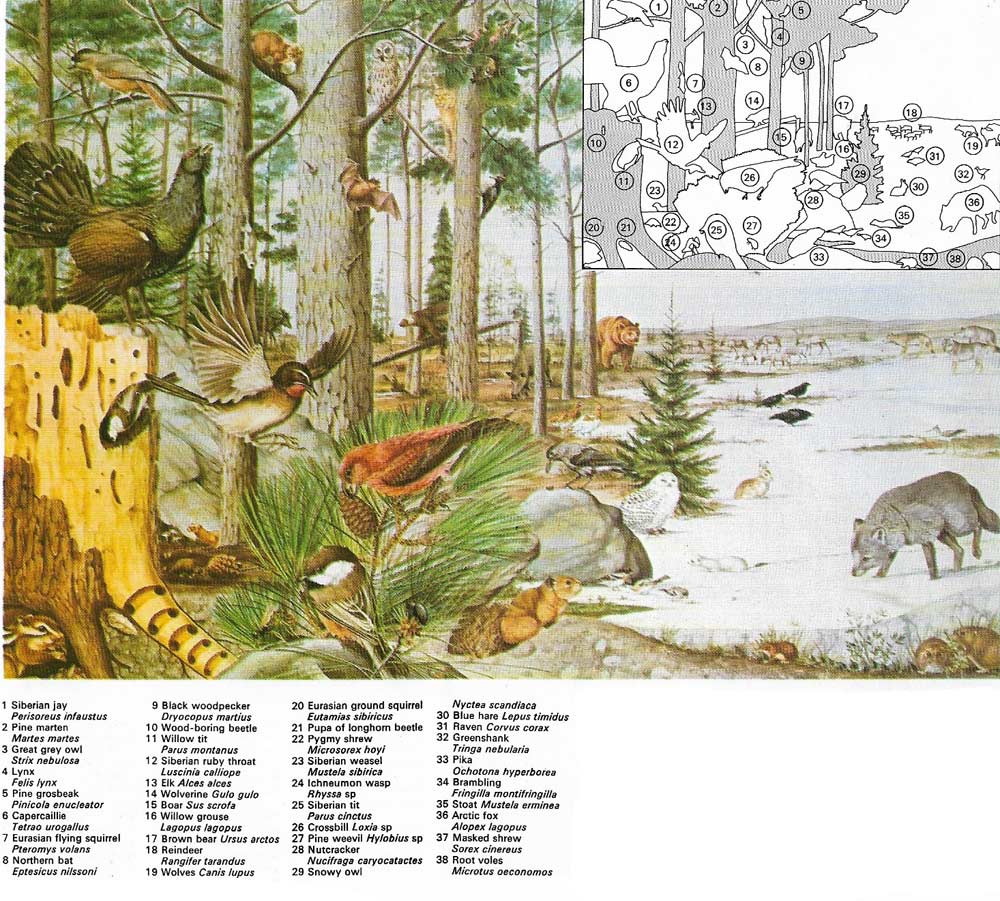
The northern edge of the pine forest abuts on to the stark tundra terrain. The winters are long and severe, but in the forest the snow is loosely packed and the soil surface remains unfrozen for most of the year. This allows animals to burrow for the winter in comfort, and ensures that insects are available for the insectivores. The evergreen conifers guarantee a continuous food supply of seeds, twigs, and buds throughout the year and most of the animals spend their time in only a restricted area of the forest, rather than migrating. Carpeting the forest floor is a layer of fallen pine needles which provides a habitat for carpenter ants, carabid beetles, and spiders. Other spiders construct their webs under loose bark on tree trunks or decaying timber. Rotten wood is a home for insects such as ants.
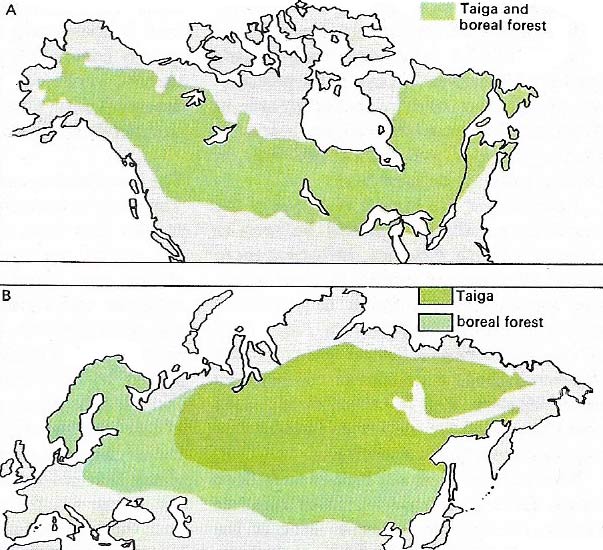
Figure 1. Pine forests stretch in the Northern Hemisphere stretch across North America (A), Europe, and Asia (B). To the south are mixed deciduous forests, to the north, sparse tundra vegetation..
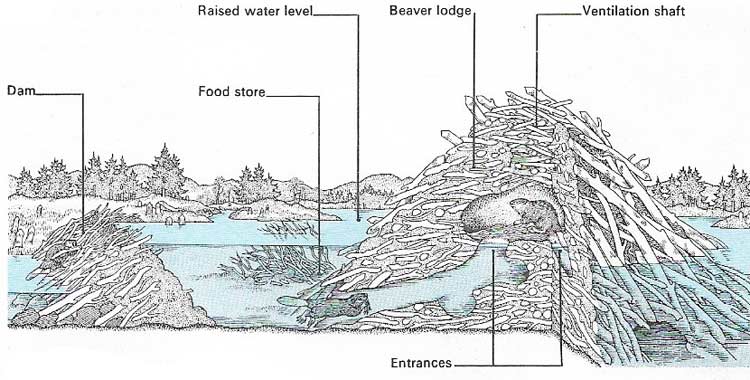
Figure 2. Beavers dam streams, creating ponds and flood passages which change the face of the landscape . In the center of the pond, both male and female of the species help in the construction of the lodge (house). Lodges vary in shape and size and usually consist of a "dining room", "living room", and "bedroom". The beavers, who mate for life, establish a family that is made up of the two most recent litters.
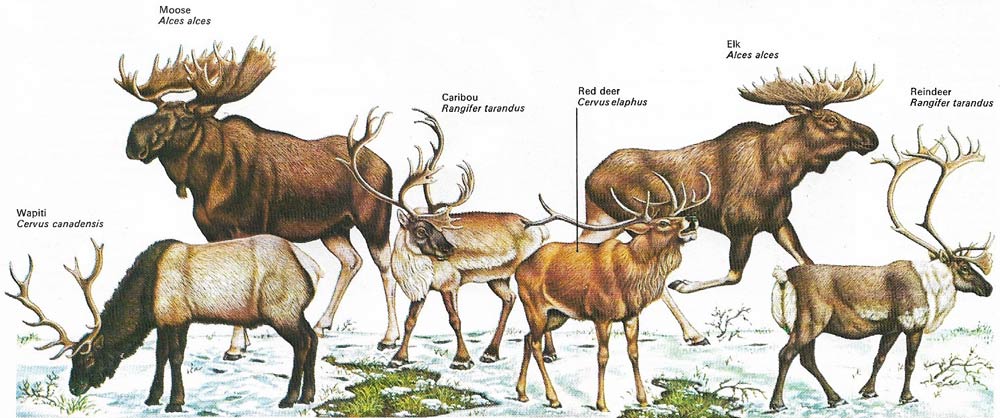
Figure 3. The tallest animal living in the forests of North America is the moose. It is identical with the elk that roams the European and Asian woodlands. The wapiti, which is confusingly known as the elk in North America, is second only to the moose in size. It is the American equivalent of the red deer, which is widespread in Eurasia, feeding on mountain pastures in summer and going down to the forest valleys in winter. Caribou are found in large herds throughout the tundra region of North America. They feed on low-growing vegetation, especially lichens or reindeer moss (Cladonia sp). In Europe and Asia caribou are called reindeer. There they lead a semi-domesticated life in herds under the case of nomadic herdsmen.
The northern pine forests stretch like a broad ribbon across the Northern Hemisphere, from the Pacific coast of Canada eastward to the Kamchatka Peninsula (Figure 1). In North America and Europe these vast tracts of land are known as the boreal forest and in Asia as the taiga – a Russian word meaning a dark and mysterious woodland. The southern boundary is marked by the blending of the pine trees and the deciduous tree varieties, although much land has now been cleared for agricultural purposes. In the northern extreme the trees are hemmed in by the vast open wastes of the frozen tundra. This wide area of colonization contains very few tree species, but scattered at frequent intervals throughout the forest are glacier-scoured lakes and slow-flowing rivers that provide a varied habitat for many animals.
Food from the pine trees
The beaver (Castor fiber), widespread throughout North America and now recovering its numbers in Europe and Asia after being almost hunted to extinction, creates its own particular niche in the habitat. Both the male and female of the species, which pair for life, engage in felling trees with their sharp front incisors and damming a stream or river to form a pond with a high water level. In the middle of the pond they build a lodge (house) where they live and raise a family of up to 12 individuals (Figure 2). A supply of young twigs is stored under water as a food supply for use during the long, harsh winter.
 |
| The beaver fells young trees with its powerful incisors and takes them to the dam or lodge in the middle of the pond. |
The main supply of food for most of the resident animals is furnished by the carboniferous trees, which provide an ample but unvaried diet of seeds, buds, bark, and young needles. The yield of these coniferous products directly controls the numbers of animals that the forest supports. Many have become specialist feeders, particularly the birds and smaller mammals. The pine grosbeak (Pinicola enucleator) feeds on the young buds, seeds, and needles, while the crossbills (Loxia specialize in taking the buds, seeds, and needles of pine and spruce. The habit of the nutcracker (Nucifraga caryocatactes) and the Siberian jay (Perisoreus infaustus) is to open the cones with their string bills. The capercaillie (Tetrao urogallus) and hazel grouse collect seeds that have dropped to the ground. The seed-eating mammals include the northern red-backed vole (Clethrionomys rutilus) and the wood lemming (Myopus schisticolor).
Many animals store up food for the winter. The red squirrel (Sciurus vulgaris) collects and hides cedar seeds and nuts in the hollows of trees and, for a special delicacy in the long, cold, dark months, impales mushrooms on spiked ends of branches.
From winter into summer
The brown bear (Ursus arctos) and the badger (Meles meles) let the cold months pass them by as they relax in a deep sleep, using up a reserve of fat which they accumulate in the autumn when food is more plentiful. The spring and summer bring relief to the beleaguered forest and, as the snows melt, young tender shoots provide sustenance for the herbivores; and multitudes of insects, a plague to man but a boon to insectivorous birds and mammals, swarm through the forest. The moose (Alces alces) (Figure 3) (know as the elk in Europe and Asia), which is the largest member of the deer family, can then stop stripping the bark of trees and grubbing for mosses and lichens in the snow and resume browsing on small shrubs and trees or aquatic plants.
The moose may be the tallest animal in the forest but the heaviest in North America is a woodland race of bison (Bison bison); and in Eurasia it is the European woodland wisent (Bison bonasis). Once widespread throughout both continents, these animals have been hunted to near extinction and now survive only in protected herds of a few hundred individuals. Another animal rescued from extinction is the sable of Eurasia (Martes zibellina),which has for many years been hunted for its valuable fur. Active conservation management has succeeded in restoring the sable population to the numbers living more than 200 years ago.
Common predators
The sable is carnivorous and drives its cousins the ermine (Mustela ermine) and the Siberian weasel (Mustela sibirica) from its home range. But these two animals are numerous in other regions along with other members of the mustelid family, such as the common weasel (Mustela nivalis). Another predator which is widespread throughout all of the northern forests of the world is the lynx (Felis lynx), a member of the cat family. A highly efficient predator it specializes in hunting hares and its numbers fluctuate according to the available food supply.
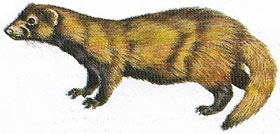 |
| The American mink is found in many parts of North America. It has webbed feet and thick fur and it is equally at home in water and on land. Mink are mainly active at night and feed on a wide variety of small animals. They are farmed for their valuable pelts, but many have escaped and returned to the wild. The mink is a member of the family Mustelidae, which includes weasels stoats, polecats, badgers, wolverines, skunks, and martins. |
The grown bear is perhaps the largest predator of the forest, but the most ferocious is the wolverine (Gulo gulo), which is amazingly strong for its size and takes prey as large as a reindeer or caribou. The wolf (Canus lupus) lives on the edge of the forest but it makes forays into the forest, hunting in well-disciplined packs to bring down animals such as reindeer and moose.
Smaller mammals, birds, and fish fall prey to the marauders of the air, such as the golden eagle (Aquila chrysaetos), the goshawk (Accipiter gentilis), the snowy owl (Nyctea scadiaca), and, in North America, the bald-headed eagle (Heliaeetus leucocephalus).


